This page has come about because, whilst wandering the Web, I came across the remarkable Compass camera shown below. Further exploration led to any number of odd cameras, and this page is only ever going to be able to show a tiny fraction of them.

FILM FORMATS
Full-frame cameras taking 24 x 36 mm images on 35mm wide film were the usual type of 'miniature' camera, though the term is obsolete and they are just called '35mm cameras'.
Half-frame cameras took 24 x 18 mm images on 35mm film, giving twice the number of pictures but half the resolution. This is the format used in professional cinemaphotography.
Sub-miniature cameras usually took images on 16 mm wide film, as sometimes used for home cinemaphotography, but there were a number of non-standard formats.

THE GEORGE P SMITH CAMERA: The first 35mm full-frame
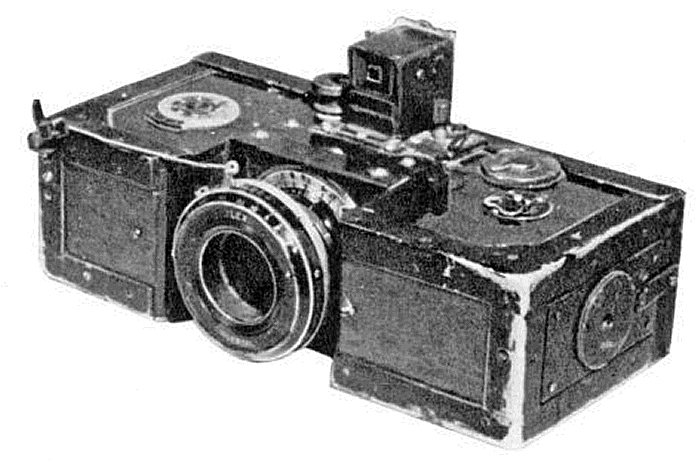 |
| Left: The George P Smith camera: 1912
The significance of this camera is that it was the first to make full-frame (24 x 36mm) images on 35mm cine film. The camera was a one-off homemade construction, and I think shows great enterprise on the part of Mr George P Smith of Richmond Heights, Missouri.
It was produced before Oscar Barnack's Leica, of which prototypes were built from 1913, but only went into quantity production with the Leica I in 1925. It was exhibited at the 1938 First National Photographic Exposition in New York, but has apparently since been lost, and no technical details seem to be available.
A few things can be deduced from the photograph. The name on the front of the lens ends in "-LEX". It looks like a bought-in lens and shutter assembly with focus, aperture and shutter speed on concentric rings. The shutter release on the lens is connected to a trigger at far left with a piece of string; this is presumably because the lens was inaccessible when you were holding the camera by its ends.
What counts as the first '35mm camera' is rather more complicated than people think. See here, and here.
|

THE LE COULTRE COMPASS CAMERA
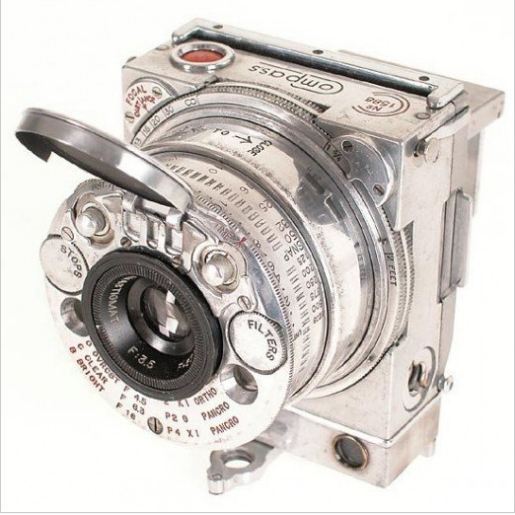 | 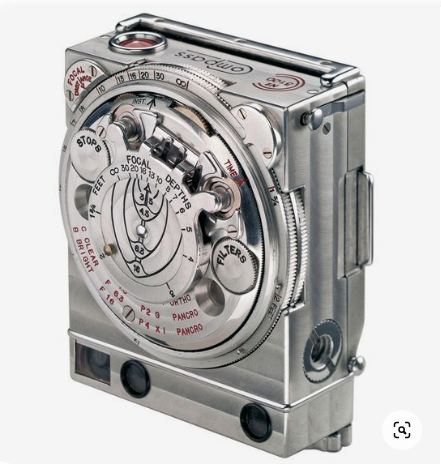 |
| Left: Le Coultre Compass camera: 1937
This rather startling camera was produced by the Swiss watch maker Le Coultre et Cie for a few years after its debut in 1937. It was designed by the notorious Noel Pemberton Billing, when he wasn't promoting ridiculous conspiracy theories. He was also a dedicated antisemite.
This shows the telescopic front of the camera with the lens cap open and closed. Almost every square millimeter of the camera carries a control or some text; note the depth of field indicator on the front of the lens cap. It measures only 6.5×2.5×5.5cm, making it less than half the size of old series Leicas such as the famous IIIG,
Amateur Photographer gives a very good account of the camera here.
|
The lens is a 35mm f/3.5 Anastigmat. The mechanical shutter speeds were from 1/500sec to 4.5secs, set on a ring around the lens. There are two little wheels each side of the lens; one sets the aperture, and the other selects yellow, orange or green internal filters, or no filter. The camera also has a built-in rangefinder, extinction exposure meter, and a spirit level; my Sony HX90 has what you would call a digital spirit level. One accessory it does not have is a compass.
The basic camera used cut film, which was hardly convenient, though the image size was the same as standard 35mm film at 36 by 24mm. A third party made a film back for Kodak’s 828 Bantam film. This film size was introduced in 1935 but was never very successful and production ceased in 1985.
The Compass was expensive, and also complicated to use, and it was not a great success. But by heaven, it looks cool!
You can see someone using a Compass on YouTube. There is lots of information.

THE JET GRAPHIC GAS-POWERED CAMERA: 35mm full-frame
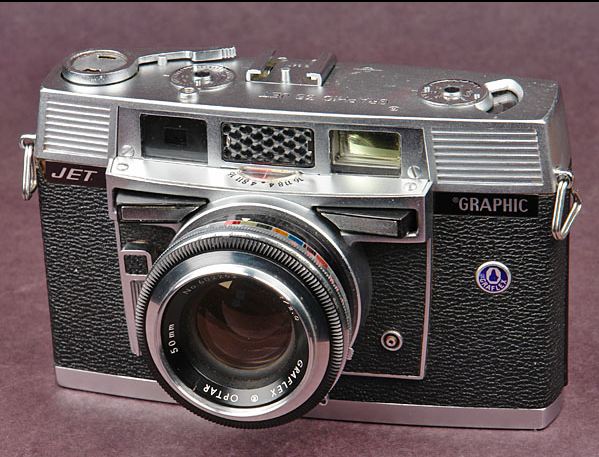 |
| Left: The Jet Graphic 35 Gas-Powered Camera: 1961
The unique feature of the Jet Graphic 35 was its gas-powered film advance and shutter cocking, using a small cylinder of compressed carbon dioxide. This was described a Jet-O-Matic Drive, a name very much of its era. There is also a manual advance lever on the top at left. It was made for the Graflex company, better known for their Speed Graphic press cameras, by the Kowa Optical Works of Japan, which is still with us. Kowa manufactured cameras from 1964 to 1978.
It has a coupled rangefinder and a match-needle coupled selenium exposure meter. The lever to the left of the lens is the shutter release. One click fired the shutter, and a further push triggered the gas drive. The instruction manual claims you could get through six to eight rolls of film one one CO2 cylinder, but that does seem optimistic. It appears that in practical use the gas drive was not reliable, due to leakage past the O-ring that sealed the gas compartment.
Focusing was by pressing the two see-saw triggers either side of the lens, a clumsy arrangement. Another odd feature of this Graphic 35 Jet is that it is focused by moving the film chamber inside of the camera body rather than by moving the lens.
The Jet Graphic 35 was only in production 1960-1961. A later model had only manual advance, so it can be assumed the CO2 drive was not popular.
|
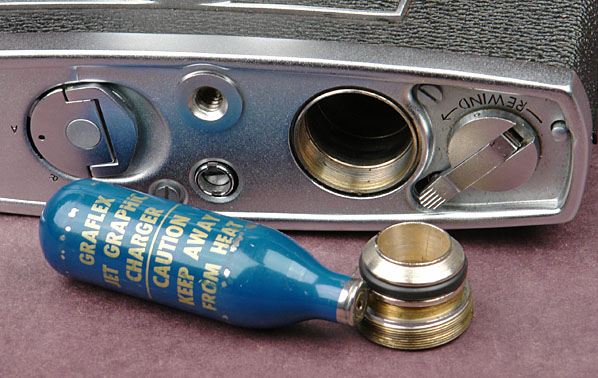 |
| Left: The Jet Graphic 35 Gas cylinder: 1961
The CO2 cylinder has GRAFLEX written on it. It is the standard 8gm size used in CO2 air-guns, or CO2-motor model aeroplanes. Note film rewind crank to the right.
The details of the gas drive are currently obscure but seem to have involved a small piston and cylinder.
There is more info on the Jet Graphic 35 here.
|
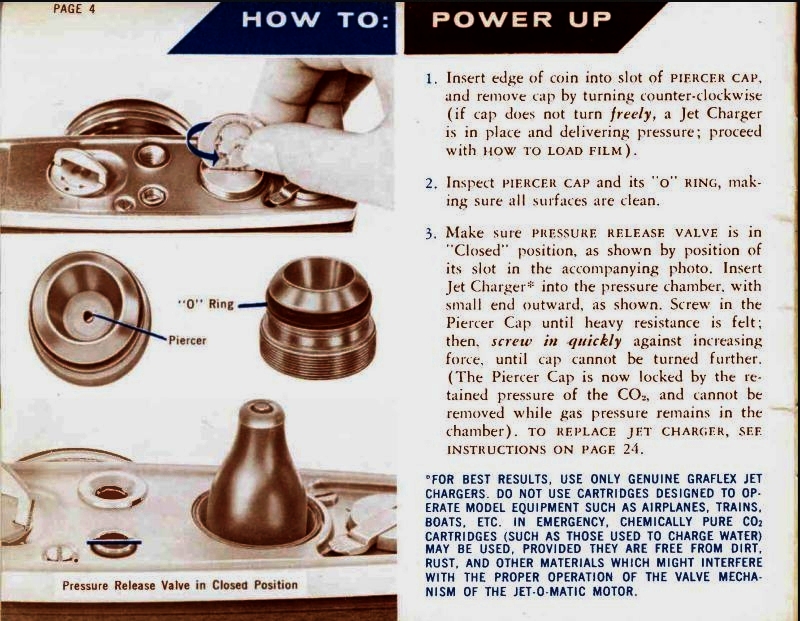 |
| Left: Instructions for fitting the Gas cylinder: 1961
This is Page 4 from the Jet Graphic 35 instruction manual.
Prepare for Jet-O-Matic Drive!
There is some more info on the Jet Graphic 35 here.
|

THE RUSSIAN PHOTOSHOP CAMERA
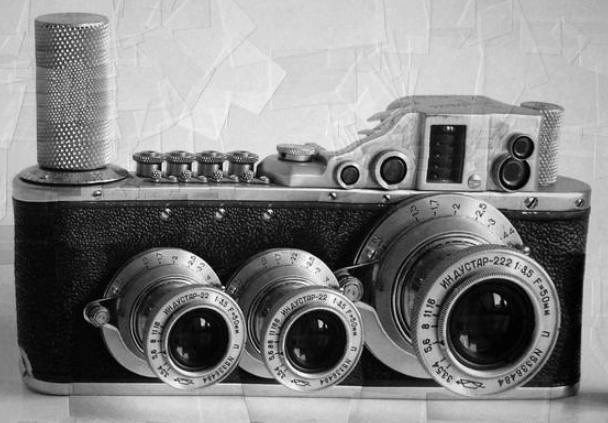 |
| Left: Photoshopped Russian camera: date unknown
Well, this looks like an extraordinary camera. Two small lenses and one big one, and four shutter-release buttons, which don't really align with the number of lenses. However it seems clear that this is just a bit of Photoshopping, starting out with a Russian copy of the Leica.
This isn't even good Photoshopping. Something has gone terribly wrong with the knurling of the knob on the left, and the rangefinder housing is all wonky, with two of its windows overlapping.
This no way to bring down the West.
|

THE UNIVEX MERCURY CAMERA: 35mm full-frame
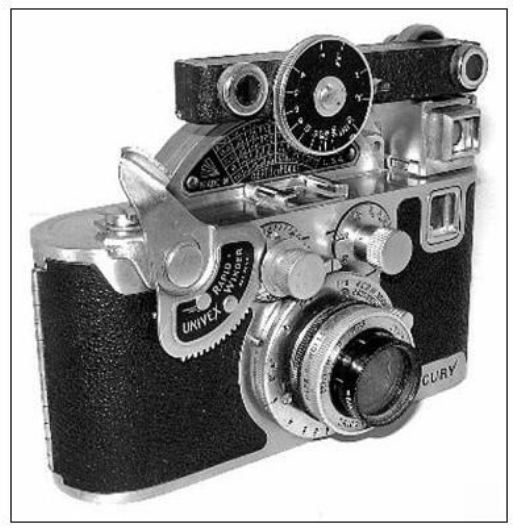 |
| Left: The Univex Mercury camera: 1938
And here's another bit of Photoshopping- except that it isn't. This monstrosity is a Univex Mercury camera, fitted with add-on rangefinder (on top) and a fast film wind lever. (At left) The big rounded housing at the back of the camera contains a focal-plane shutter in the form of a revolving disc. This gave unusually accurate speeds up to 1/000 sec.
There is more info here.
|
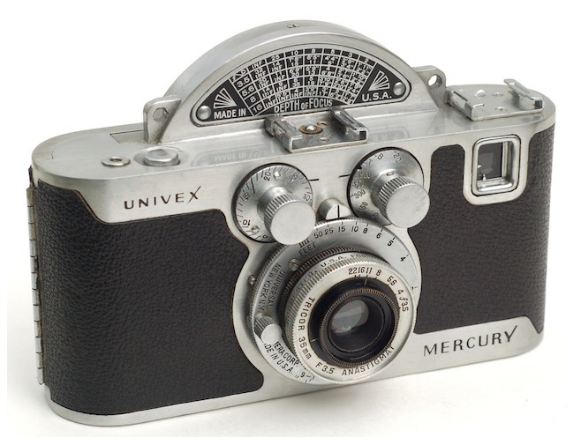 |
| Left: The Univex Mercury camera: 1938
This is a Univex Mercury camera without the rangefinder and fast film wind lever. Aperture is set by the ring on the front of the lens, and focus by the larger ring behind it. The small knob on the right sets the shutter speed. The small knob on the left appears to be the film advance, with a coaxial ring showing the number of the exposure.
|

THE OLYMPUS O-PRODUCT CAMERA: 35mm
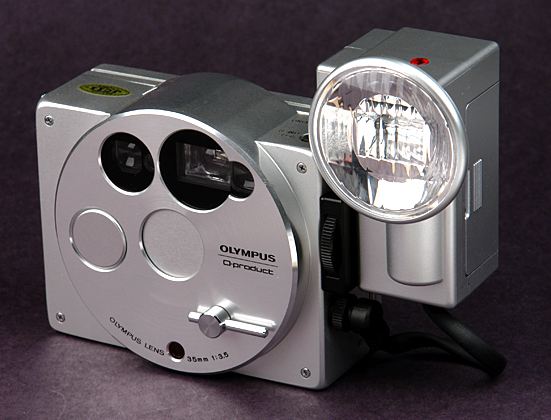 |
| Left: The Olympus O-Product: 1988
This seductive piece of machinery, introduced in 1988, is the Olympus O-Product camera, with the external flashgun attached. While it is unquestionably a beautiful and cool piece of machinery, its actual capabilities as a camera were pedestrian, and provoked criticism from reviewers.
The 35mm lens had a maximum aperture of only f/3.5, which could only be stopped down to a minimum of just f/9. The shutter speeds ranged only from 1/45th sec to 1/400th sec. The film speed was set by DX-coding contacts in the film compartment, but gave only four ISO speeds of 50, 100, 400, and 800, obtained by reading only three of the twelve DX contacts.
The shutter release is the silver disc to the left. The intriguing lever operates the lens cover. The only other manual control is a button to start the self-timer, placed on the top of the camera. Below it is a recessed button marked 'REWIND' though quite how the rewinding was done is not currently clear. No crank is visible in the pictures I have seen.
The camera was highly successful; it was produced in a limited run of 20,000 units, and every one was sold. Apparently the 16,000 allocated to the Japanese market were all sold before a single camera had left the factory.
There is some more info here.
|
HALF-FRAME & SUB-MINIATURE CAMERAS

THE KUNIK WALTER PETIE VANITY CAMERA: 17mm
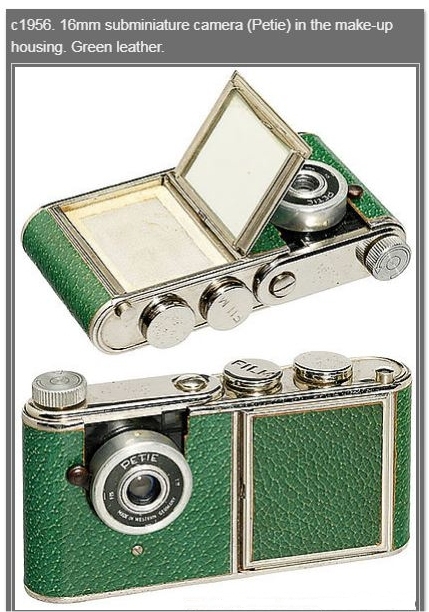 |
| Left: Kunik Walter Petie vanity camera: 1956
This extraordinary device is a combination of a camera and a face powder compact. This sounds like a less than brilliant idea on the face of it, as the powder would be likely to get onto the lens, and possibly into the camera mechanism. Nonetheless it's a rather beautiful object.
The Petie cameras were distributed by Walter Kunik of Frankfurt am Main in Western Germany during the 1950s and early 1960s. The cameras were built by various manufacturers.
The Petie has a 25mm f9 fixed-focus lens, and a single shutter speed of 1/50 sec.
The Petie took 16 exposures of 14x14mm format on 17mm roll film. Such a small negative gave poor results and the camera was not a success.
Powders other than face powder could be carried instead.
|
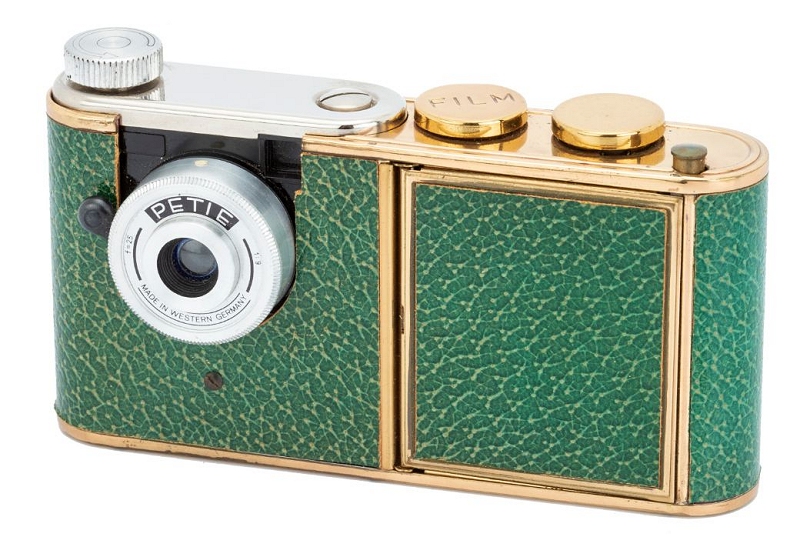 |
| Left: Kunik Walter Petie vanity camera: 1956
Here is another example with gold trim. The camera body only goes up to the end of the silver top-plate, and has been inserted into the larger body holding the compact. This seems to leave quite a bit of room under the powder tray, which other stuff could be stashed. The camera controls are the film advance knob to the left, and the shutter release button on the silver top-plate. The other two knobs are not part of the camera (although one has FILM written on top) and their purpose is currently unknown. The small button at the right releases the lid of the powder compact.
This example sold for £860 at auction.
There is much more info here.
|
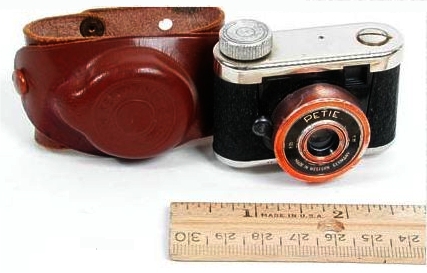 |
| Left: Kunik Walter Petie camera: 1956
Here is a Petier camera by itself. As the scale shows, it was a subminiature camera, being only some 5 cm wide.
|
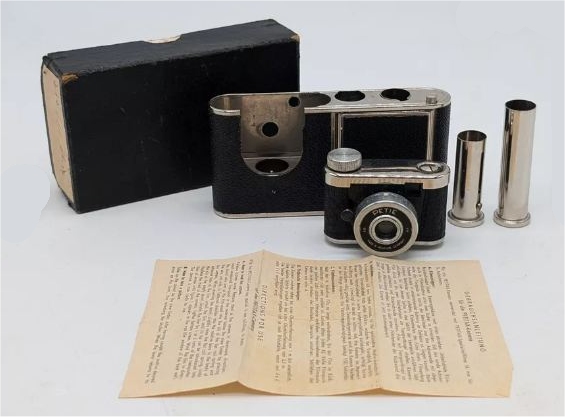 |
| Left: This shows the camera removed from the vanity case: 1956
This shows that the mysterious knobs are actually the tops of two different-sized containers. For lipstick? Is the smaller one intended to hold a spare film? Probaly, but we don't know for sure which cylinder has FILM written on top.
At the back is the box it came in.
|

THE DORYU 2-16 GUN-CAMERA: 16mm
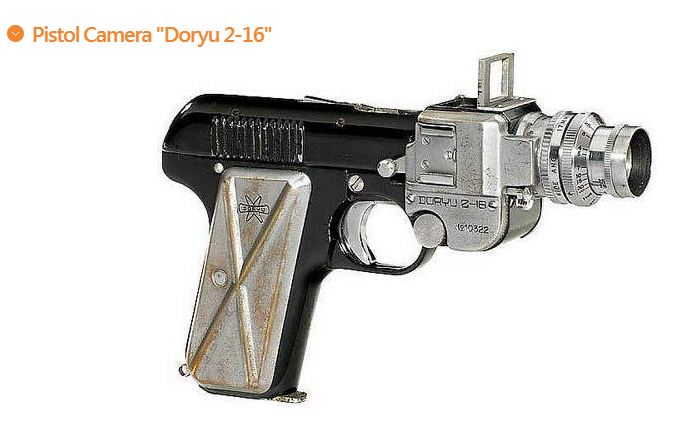 |
| Left: The Doryu 2-16 Gun-Camera: 1954
This the Pistol Camera Doryu 2-16. It was developed in Japan in 1954 for police use, the idea being you could take a picture with one hand. (The other hand persumably holding a real gun) It seems to have been especially designed for photographing demonstrations. This followed the clash between police and Tokyo protesters in the Bloody May Day Incident of 1952, in which the police opened fire on demonstrators, killing 2 and injuring 22.
It used standard 16mm film, with each image only 10×10mm. The trigger released the shutter, which had speeds of 1/25, 1/50, and 1/100 seconds. The original 17mm f/2.5 fixed focus lens could be changed for other C-mount lenses. The camera was not adopted by the police, having poor picture quality and suffering from light leakage. And also...
The most daunting problem with the Doryu 2-16 was the bizarre flash system. It appears this was triggered every time the shutter was fired, whether you wanted it or not. The handgrip contained a magazine that held six magnesium cartridges, one of which would pop out of a slot in the gun just behing the camera body and be ignited by a paper strip holding gunpowder, as in a cap gun. Sounds like you could get it in your eye, especially since the slot is just behind the viewfinder. This sounds very odd but all sources agree that's how it worked.
There is some more info here.
And some more info here.
|

THE MINICORD TWIN-LENS REFLEX: 16mm
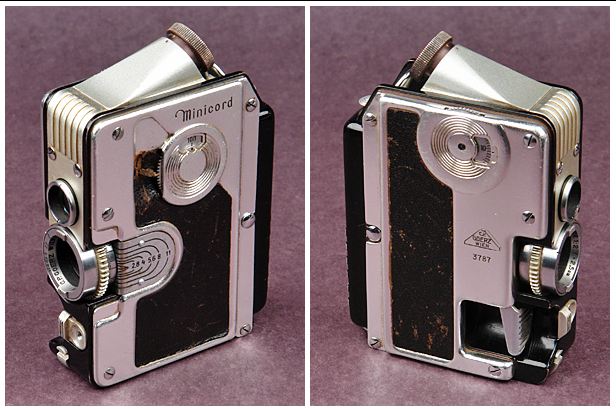 |
| Left: The Minicord Twin-Lens Reflex: 1951
The 16mm Minicord is believed to be the only 16mm Twin-Lens-Reflex (TLR) camera ever built. It is slightly larger than a pack of cigarettes. It was made by C P Goerz of Austria in 1951. The taking lens is a six-element coated Helgor 25 mm f2, focusing from 12 inches to infinity. The all-metal focal plane shutter gives speeds of: B, 1/10, 1/25, 1/50/, 1/100, 1/200, 1/400 sec.
Left Photo: The dial at the top of the body sets the shutter speed. The aperture is set by turning the two projections on the front of the len. The threaded ring sets the focus; next to it is a depth-of-field scale.
Right Photo: The dial at the top of the body is the film counter; it can be set by means of the knurled edge at the top. The trigger seen at bottom right advances the film and cocks the shutter.. Next to it on the front of the camera is the shutter release.
|
 |
| Left: The Minicord Twin-Lens Reflex: 1951
Unlike an ordinary twin lens reflex camera, the Goerz Minicord viewfinder image is not only right side up, but also unreversed, as a prism is used instead of a mirror.
I think this is a very nice bit of machinery.
The Minicord has a Wikipedia page.
|
 |
| Left: Not the Minicord Twin-Lens Reflex: 1956-58
This is a Russian copy of the Minicord, called the Compacta. It was clearly not a totally faithful copy; for example the shutter speeds were restricted to 1.8 to 1/250 sec. The view finder arrangements look different, with a big window at the right; the details of this are currently unclear. There are many other minor differences such as the design of the shutter release.
There is more info here, if you can read Russian. It says the camera was "not released seriously" which presumably means it saw only limited production.
|

THE TESSINA CAMERA: 35mm half-frame
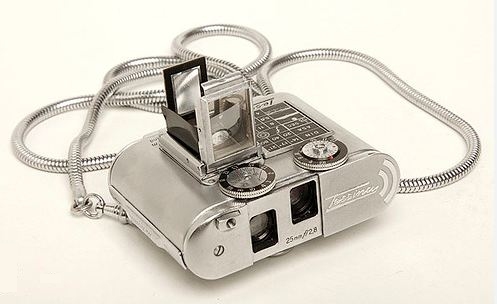 |
| Left: The Tessina Camera: 1957-96
The Tessina was a subminiature twin lens reflex camera measuring 2.5 x 2 x 1 inch, that took 14 x 21 mm pictures on standard 35mm film (a significant advantage over other sub-min cameras) loaded into special cassettes. This is slightly smaller than standard half-frame format. It took 18 pictures per film roll. The Tessina was produced from 1957 to 1996.
The camera has two 25 mm f/2.8 Tessinon lenses, one for the picture and one for the viewfinder, which has a ground-glass screen on top if the camers. A 45° mirror is employed to reflect incoming light onto the film, which lies on the bottom of the camera. Another 45° mirror directs light up to the viewfinder. It could focus from infinity to 1 foot. The lens aperture was continuously variable down to f/22. Shutter speeds were from 1/2 to 1/500, plus B. The film was advanced by a clockwork spring built into the takeup spool, wound up with a pull-out knob. Each winding was good for up to 8 exposures. Quite sophisticated, really.
The wheel on the left is for focusing and has a depth-of-field indicator. The wheel on the right combines the frame counter and the aperture control.
|
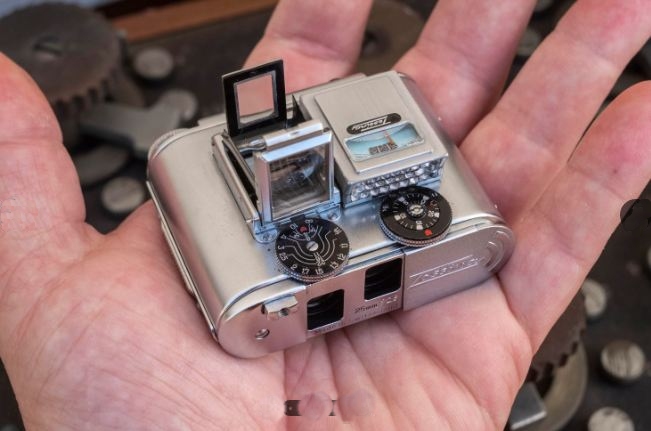 |
| Left: The Tessina Camera: 1957-96
This gives a good idea of the small size of the Tessina. This one is fitted with a selenium exposure meter to the right of the viewfinder; it was claimed to be the smallest exposure meter in the world.
The taking (picture) lens is the upper one in the middle. The viewfinder lens is below and to the left. The shutter release is the bar just to the left of the viewfinder lens. To the right front of the camera is a sliding lens cover.
There is a good deal more info here.
The Tessina has a Wikipedia page.
|
 |
| Left: The Tessina Camera controls
The film transport release for rewinding is just visible below the shutter-speed dial.
Source: Camera Collector column by Jason Schneider published in January 1994.
|
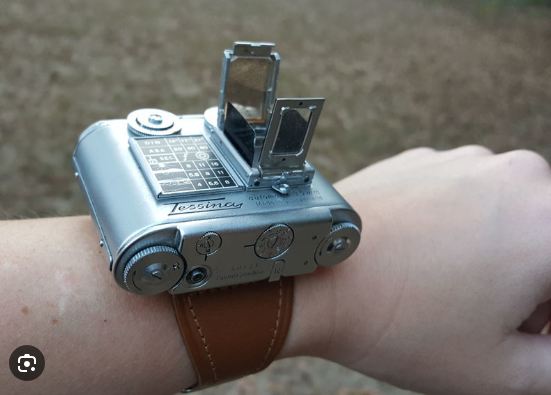 |
| Left: The Tessina Camera: 1957-96
One of the accessories available was a wrist strap so the Tessina could be worn like a watch. Every secret agent should have one.
|

THE YASHICA RAPIDE
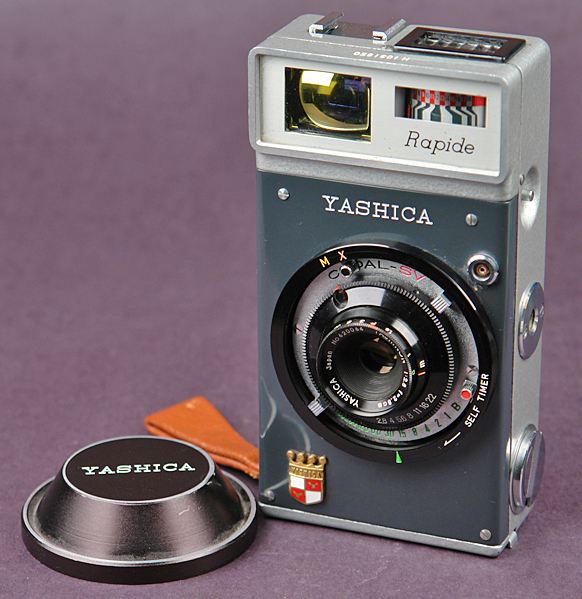 |
| Left: The Yashica Rapide: 19??
The Yashica Rapide was a 35mm half-frame viewfinder camera manufactured by the Japanese company Yashica around 1961. The main reason for it being considered Unusual is the vertical rather than horisontal format of the camera.
The lens was a Yashinon of 28mm f2.8. The shutter was a Copal-SV giving speeds from 1 to 1/500sec.
There is a little more info here in camera-wiki.
|

THE MAMIYA 16 AUTOMATIC CAMERA
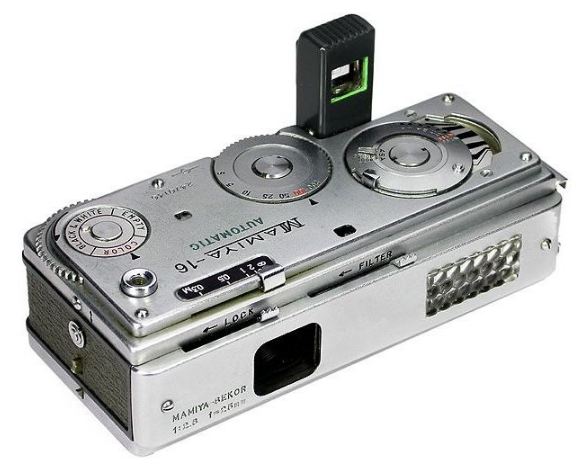 |
| Left: The Mamiya 16 Automatic Camera: 1959
The Mamiya 16 is a sub-minature camera giving 10 x 14mm images on standard 16mm film. This is a very neat little device. It was manufactured from 1959 to 1962; the last date is uncertain.
One slider on the front covers the lens and locks the shutter, the other puts a yellow filter in front of the lens. It has a small swivelling optical viewfinder.
The Mamiya-16 has a Mamiya-Sekor f2.8 25mm lens, stopping down to f16. Focusing down to 1 foot is manual by a slider at the top front of the camera; there is no rangefinder.
There were several earlier versions of the Mamiya 16 without an exposure meter.
There is some more info on Camera-Wiki. What relationship that has to Wikipedia I am not sure.
|
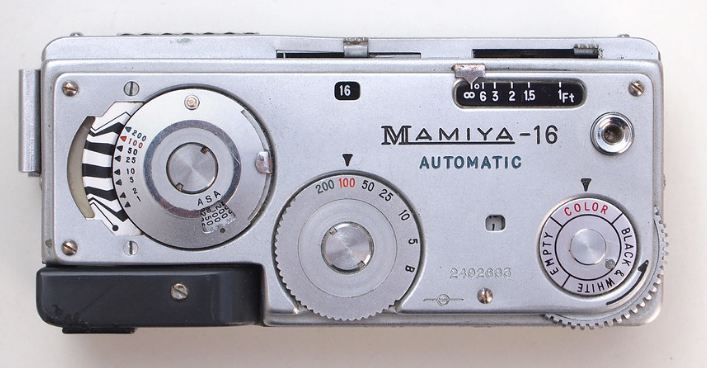 |
| Left: The Mamiya 16 Automatic Camera: 1959
Shutter speed is set by the thumbwheel at the centre. The shutter release is the round thing at top right. Aperture is controlled by the left wheel, with its setting shown in the little black window at top centre, showing '16'. Matching the shutter speed to the needle of the selenium exposure meter sets the exposure.
At right is a thumb-wheel for film advance and a film-type reminder. The frame number is shown in a tiny window just to the left of the film-type reminder.
There is some more info here.
|

THE MINOLTA 16 CAMERAS
 |
| Left: The Minolta 16 II Camera: 1960
Minolta 16 refers to a series of 16mm subminiature cameras manufactured by Minolta between 1955 and 1974.
The 16 II was the third in the Minolta-16 series. It offered shutter speeds of 1/30 to 1/500 plus B, and apertures from f2.8 to f16. There was a version of this camera that had a transistor radio built in; it was called the Sonocon 16 MB-ZA, and manufacture began in 1962. It used single-perforated 16 mm film.
On the left side of the camera are two thumbwheels; the further sets the aperture and the nearer the shutter speed. The shutter release is the square button on top. After taking a picture the camera is pushed together then pulled apart to cock the shutter and advance the film. The film counter is a tiny window on the underside of the camera.
The viewfinder is the window on the right. The small black hole on top at left is the flash connector.
The Minolta 16 has a good Wikipedia page.
|
 |
| Left: The Minolta 16 QT Camera: 1972-74
Minolta 16 QT was the final model in the 16 series; it was made from 1972 to 1974.
The 16 QT has a 23mm lens with manual focusing, aperture variable from f/3.5 to f/22 and two shutter speeds of 1/30 and 1/250 sec. It includes an exposure meter.
The aperture is set by the thumbwheel on top, and one of the two shutter speeds by the black lever to the left of it. The round thing on the front of the camera is for film speed setting, with a cadmium sulphide cell window in the centre of it. The shutter release is the round chrome button on the top of the camera. The film counter is a tiny window at the rear of the camera top.
Focusing (in 4 zones) is by a slide on the bottom of the camera underneath the lens. The only depth of field indication is a table in the printed manual.
The viewfinder is the window on the right.
|

THE MINOX SPY CAMERA
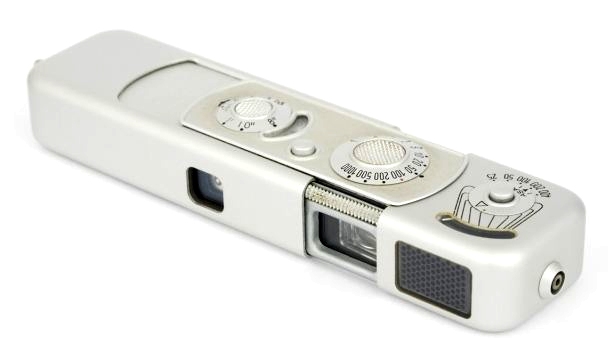 |
| Left: Late production Minox-B Camera: 1960s
The Minox is the iconic spy camera, and it really was used for espionage by both sides during the Cold War. This was not only because of its small size, but also because its lens could focus as close as 20 cm, making it ideal for photographing documents. The Minox cameras produce an image of 8×11 mm on the film, which is in strips 9.2 mm wide, less than one-quarter the size of 35 mm film. Unlike 35 mm film, it has no sprocket holes. The film strips can be up to 50 frames in length.
The Minox B shown here became the most popular Minox model. It was made from 1958 to 1972, and incorporated a selenium exposure meter requiring no battery. The camera slides open to reveal the lens and the viewfinder window. The exposure meter is to the right, and the shutter speed is set on the dial above the lens. To the right of that is a small round shutter release button, and the leftmost dial is for focusing and has a depth-of-field window.
The Minox was invented by Walter Zapp in 1936.
Minox still exists as part of the Blazer Group GmBH. Production of 9.2mm film ended in 2015.
The Minox has a very comprehensive Wikipedia page.
|
LARGE FORMAT CAMERAS

THE VEGA FOLDING CAMERA
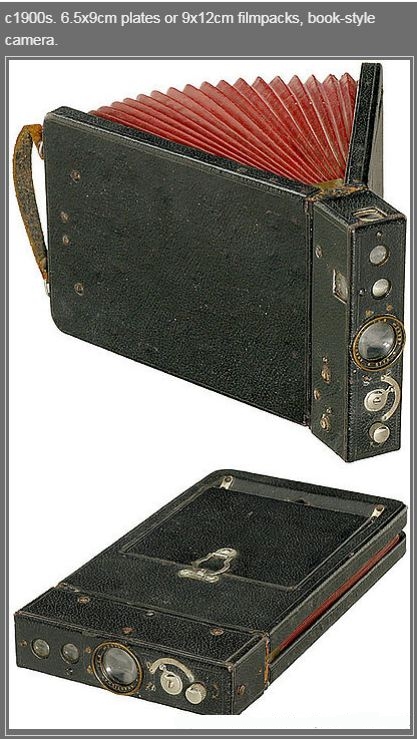 |
| Left: The Vega folding camera: 1900
This remarkable device is a side-folding camera using 9 x 6.5cm plates. 12 plates are carried in holders in the pivoted frame; when a plate is exposed it is transferred to the bottom of the pack by opening and closing the camera.
The Vega has a rapid rectilinear lens, a sliding plate giving two apertures, and an I and B shutter cocked by the plate changing mechanism. There are two brilliant reflecting finders, viewed from the top or the side. The camera is flat when closed, and opens sideways by means of the bellows, giving a triangular shape with the lens at the apex. It has an exposure counter.
Be aware there are other cameras called Vega. One example is the Kiev Vega, a subminiature camera made by Arsenal Kiev from 1960 to 1962. It uses unperforated 16mm film, similar to the Minolta-16 camera.
|
PANORAMIC CAMERAS

THE MEOPTA PANKOPTA
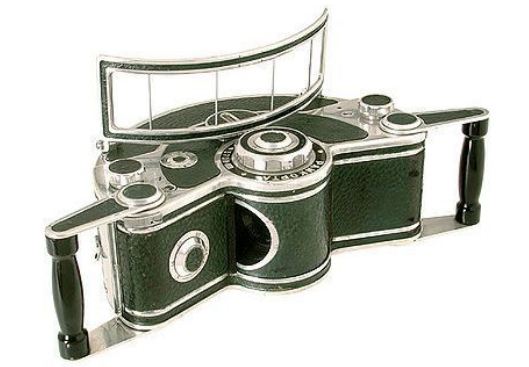 |
| Left: The Meopta Pankopta: 1962
The Meopta Pankopta is a panoramic camera; these were used mainly for taking big group pictures of school pupils and so on, using a curved film back and a swivelling lens. Meopta is a Czech-based manufacturer of optical goods and still exists.
The camera takes just three 55 x 235mm images on a 120 film roll. The swivelling fixed-focus lens is a Belar f4.5 105mm giving a 135º view angle. Shutter speeds were 1/5, 1/10, 1/25, 1/50 and 1/100 sec achieved by altering the lens swivelling speed. Yhe apertures were f4.5, f5.6, f8, f11 and f16.
The camera has two spirit levels (for front-rear and left-right levelling) on the top surface. There are handles on each side which fold towards the front for storage.
There is a folding wire-frame viewfinder on top.
The camera was described in French Patent 1,240,129.
Very few of these exist and they command high prices, say 12,000 Euros.
There is some more info here, in Camera-Wiki.
|
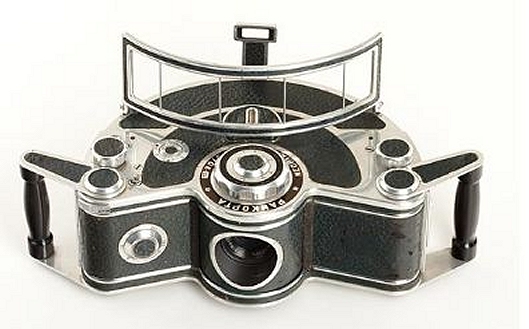 | | Left: The Meopta Pankopta: 1962
The button on the left front of the camera appears to be the shutter release.
There is a good deal of info on the Meopta company here. It is in Czech but the Chrome browser translates it nicely.
|
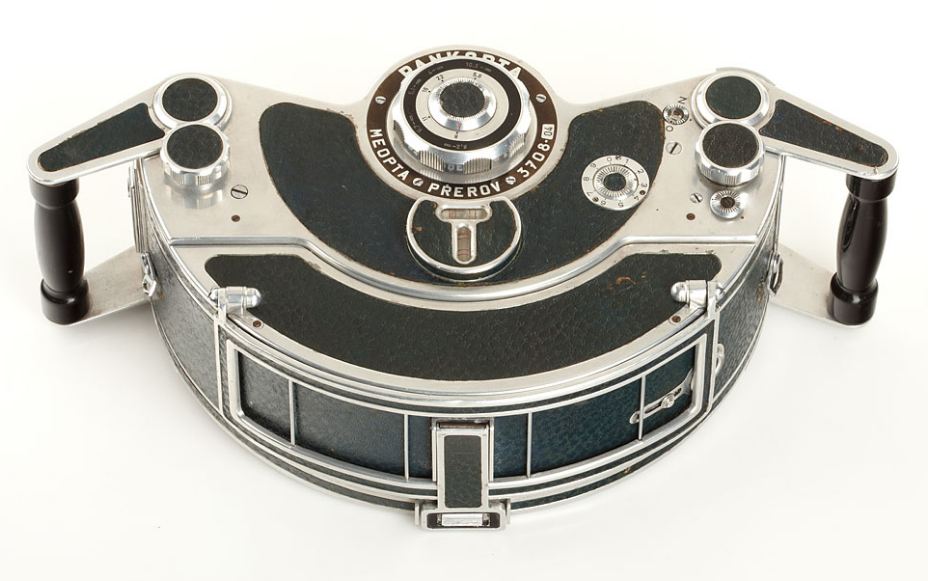 |
| Left: The Meopta Pankopta: 1962
This shows how the wire-frame viewfinder folds away at the curved back of the camera. The peephole at the rear swings up independently for use.
The two orthogonal spirit levels can be seen just below the big knob. To the right is what appears to be the frame counter. It is believed the big knob set the aperture, but this is so far unconfirmed.
It is not known how the film traverse speed was set.
|

THE WIDELUXE PANORAMIC CAMERA
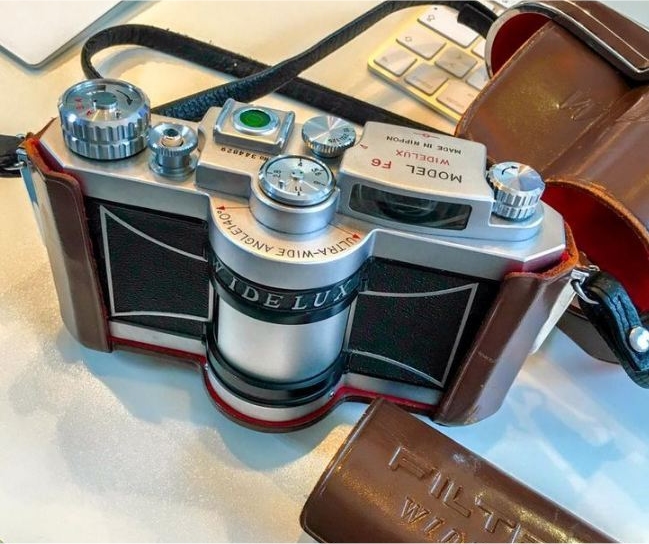 |
| Left: The Wideluxe F6 panoramic camera: 1958-2000
The Wideluxe cameras were made by Panon Camera Shoko, a small-scale Japanese camera manufacturer, founded by Nakayama Shozo in 1952. Versions to use 35mm and 120-format were made.
Only three shutter speeds were available on models up to and incuding the F6; these were 1/5, 1/50 and 1/200 sec. Later models had 1/15, 1/125 and 1/250 sec. Note the wide viewfinder window and the green circular spirit-level.
The Wideluxe camera has a useful Wikipedia page.
The Wideluxe is one of the better-known panoramic cameras because it has been used extensively by actor Jeff Bridges. There is more information on that here.
|

THE PIGEON CAMERA
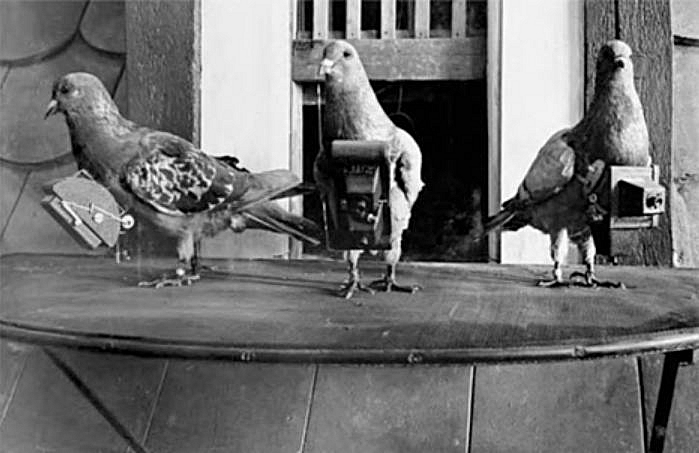 |
| Left: The Neubronner Pigeon camera: 1907
Julius Neubronner made some tiny harnesses to hold cameras onto carrier pigeons in the early 20th century. The idea was that the pigeons would fly over an area of interest (military objectives come to mind) and a timer in the camera tripped the shutter. It was tried out in the early days of WW1 but was not adopted.
Several thoughts occur. Firstly, those camera look rather heavy and bulky, and I am surprised the pigeons could take off.
Secondly, traditionally carrier pigeons would be carried to a remote spot, and then they would fly back to their home, which would rather limit their scope. However, by placing their food at one place and their home at another place, pigeons have been trained to fly back and forth up to twice a day reliably, covering round-trip flights up to 160 km. (100 mi) With a bit of careful positioning you could probably get the pigeon to fly over a contested salient. Setting the camera timer must have been tricky.
I am inclined to think that this is not a nice way to treat pigeons.
Julius Neubronner has a comprehensive Wikipedia page.
|
STEREO CAMERAS
Stereo cameras take two pictures at once with lenses spaced apart horizontally. When the two images are looked at with the proper viewer, they fuse to give a 3D effect. I say 'effect' because our direct vision uses a number of depth cues, whereas this system use only one- the parallax between the two images. The result is a sort of cardboard-cutout effect that is not real 3D, and in my case rapidly gives me a headache. This is why 3D cinema films appear in cycles, disappearing again when the audience realises it is uncomfortable to watch for very long.
There have been many stereo cameras, so here we focus (Ha!) on unusual stereo cameras.
THE HOMEOS STEREO CAMERA
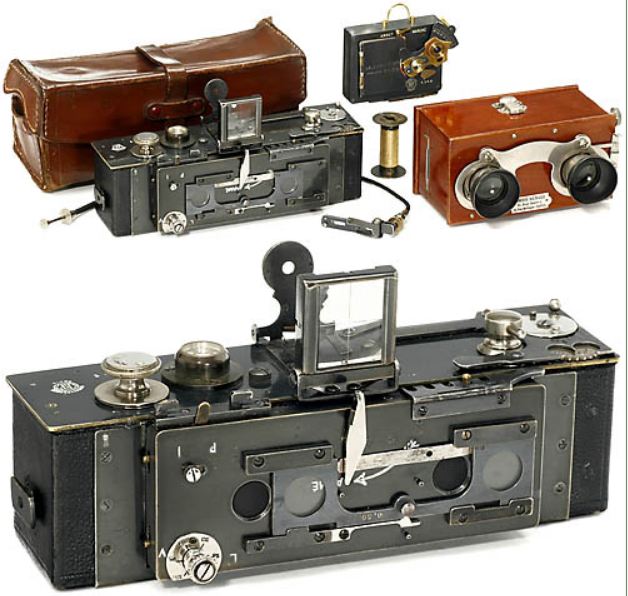 |
| Left: The Homeos stereo camera: 1913
The significance of this camera is not the fact that it takes stereo photographs, but that it was only the second camera to be produced for 35 mm cine film and the first to be patented. The first was the The George P Smith camera at the top of this page) It was produced before Oscar Barnack's Leica, of which prototypes were built from 1913, but only went into quantity production with the Leica I in 1925. The 'Homeos' stereo camera was produced by Jules Richard for 35mm film in 1913. This camera carries the inscription: "Homeos Richard".
The two lenses were marked Anastigmat f4,5/28mm. The short focal length is due to the half-frame images on the film; it produced stereo pairs of 18 x 24mm on 35 mm cinematographic film. Full-frame cameras take 24 x 36 mm images on the same 35mm wide film.
There is more info on the Homeos here.
|
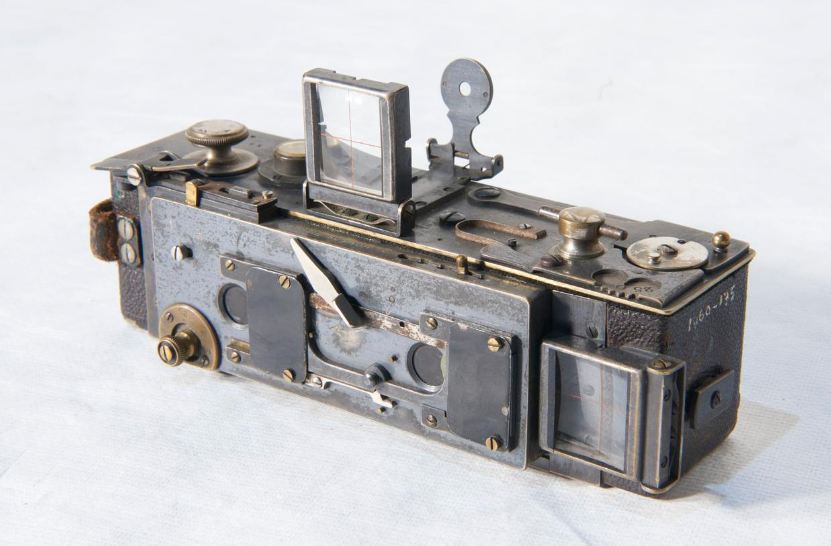 |
| Left: The Homeos stereo camera: 1913
This is another example of the Homeos Stereo Camera, this one being in the Science Museum, London.
Note that this example has an extra folding viewfinder with crosshairs at the right end of the camera.
There is a bit more info here.
|
THE CUPIDO-STEREOLETTE STEREO CAMERA
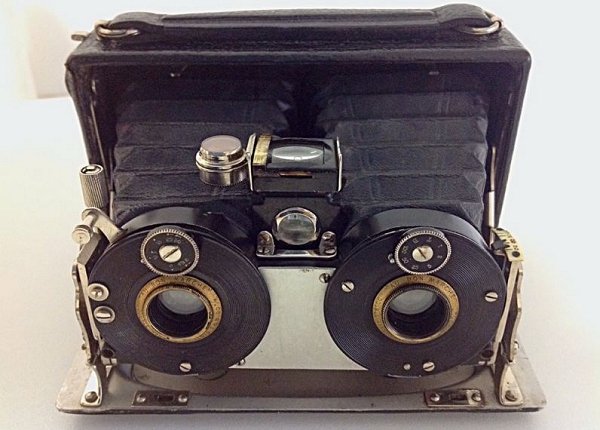 |
| Left: The Cupido-Stereolette stereo camera: 1907
The extraordinarily-named Cupido-Stereolette stereo camera was made by ICA AG of Dresden, Germany, between at least 1907-1912. The twin bellows are the unusual feature.
The camera took a stereo pair of images on a 45 x 107 mm glass plate or cut film. The twin lenses were Carl Zeiss Jena Tessar 45mm / 65 mm. Apertures were from from f4.5 to f25.The twin Compur shutters offered Z, B, and 1 sec to 1/250sec, set by the two small dials above the lenses. Focus adjustment of 1 m to infinity was by radial lever; this lever has not yet been identified on the photograph.
There is a bit more info here on Camera-Wiki.
|
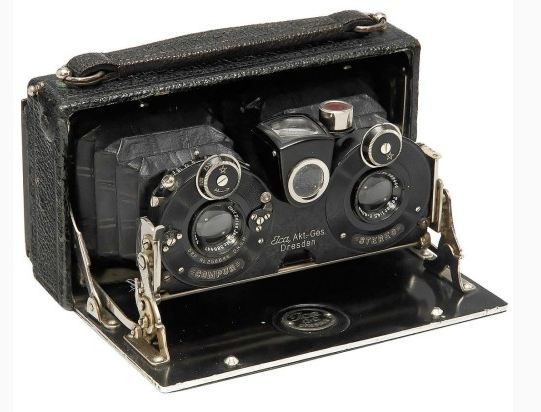 |
| Left: The Cupido-Stereolette stereo camera: 1907
This is a slightly different version. Note the waist-level viewfinder between the two bellows. The round thing beside it is a circular spirit level, because you really do want stereo pairs horizontal.
There is more info here.
|
THE HÜTTIG IDEAL STEREO CAMERA
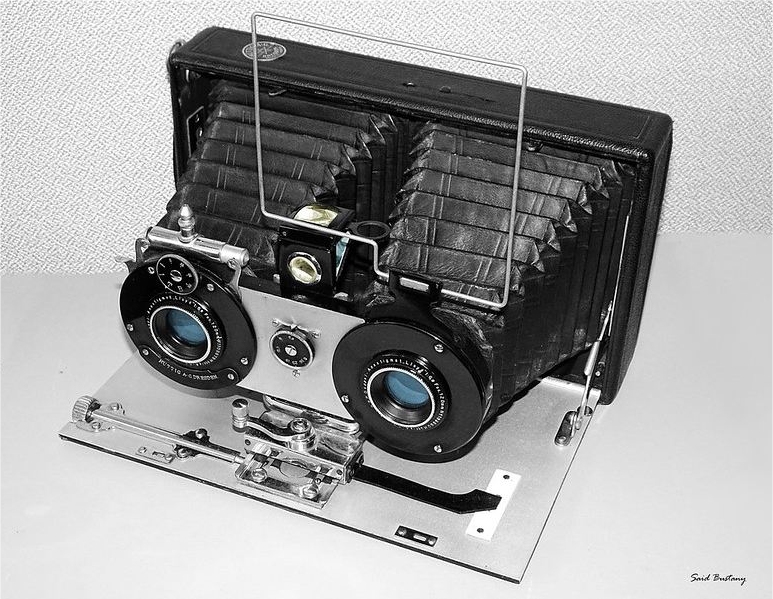 |
| Left: The Hüttig Ideal Stereo camera: 1908
Further investigation shows that having two bellows on a stereo camera was not that unusual. This is a Huettig Ideal Stereo camera made by R. Hüttig AG, of Dresden, Germany.
It produces a stereo pair of images on 9 x 18 cm plates. Each lens was a Hüttig Extra-Rapid Aplanat f8/125 mm, and had a two-blade shutter giving T, B, and 1 to 1/100 sec exposures. The shutter speed was set by the dial just above the left lens; presumably this controlled both shutters. Just behind this dial is what appears to be a piston-and-cylinder combination; this is probably a pneumatic self-timer.
Focusing was by rack and pinion, using a ground-glass back. Note right-angle and wire-frame viewfinders.
|
SMENA STEREO PROTOTYPE CAMERA
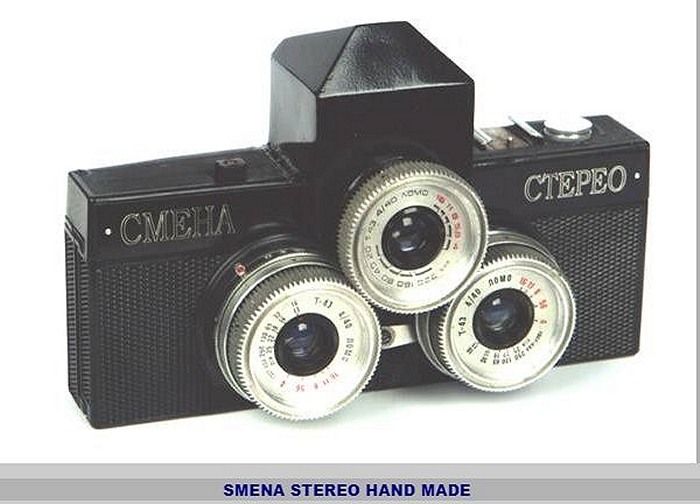 |
| Left: Prototype Smena stereo camera: 195?
This bizarre camera looks as though it might be Photoshop, but it appears it is a real prototype of an intended Russian Smena stereo camera with a pentaprism viewfinder and a third lens identical to the two taking lenses. This would allow focusing on a ground glass screen of an image that was identical to that seen by the two taking lenses.
The three lens are geared together so they focus simultaneously. Unfortunately the taking lens on the left seems to be out of mesh with the central one, and has a different distance setting.
There is some info on Smena cameras on Wikipedia, but this prototype is not mentioned.
|
 |
| Left: The standard Smena stereo camera: 195?
This is the standard version of the Smena stereo camera, with a simple viewfinder.
There was a whole series of manual Smena cameras, most of them not being stereo. The first was introduced in 1953.
|
GIANT CAMERAS
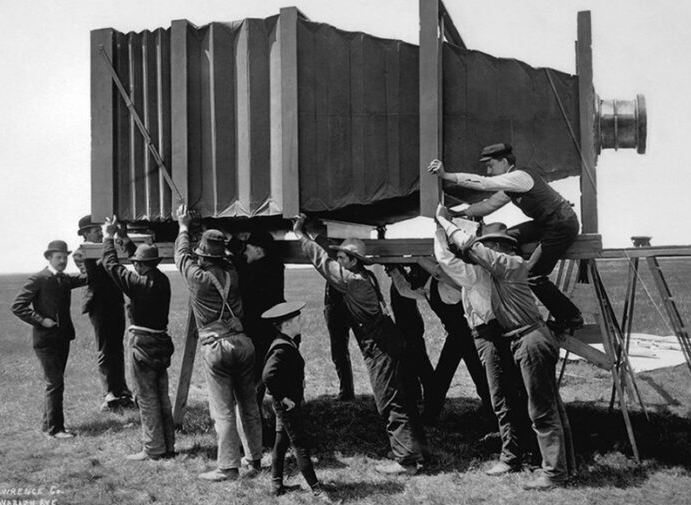 |
| Left: The Lawrence giant camera: 1900
You have almost certainly seen this photo, or others like it, of the Lawrence Camera. It is sometimes said to be the world's first camera which is of course nonsense.
This is however often claimed to be the world’s largest camera. It was built in 1900 by Chicago camera builder J.A. Anderson, for the photographer George R. Lawrence. Lawrence was commissioned by the Chicago & Alton Railway to photograph of one of its trains, requiring a glass plate 8 feet by 4.5 feet that itself weighed 500 pounds. The camera (not including plate) weighed in at 900 pounds, and required 15 men to move and operate it. The build cost was quoted as $5,000, which I call a suspiciously round figure.
There is a good deal more info here.
|
















































